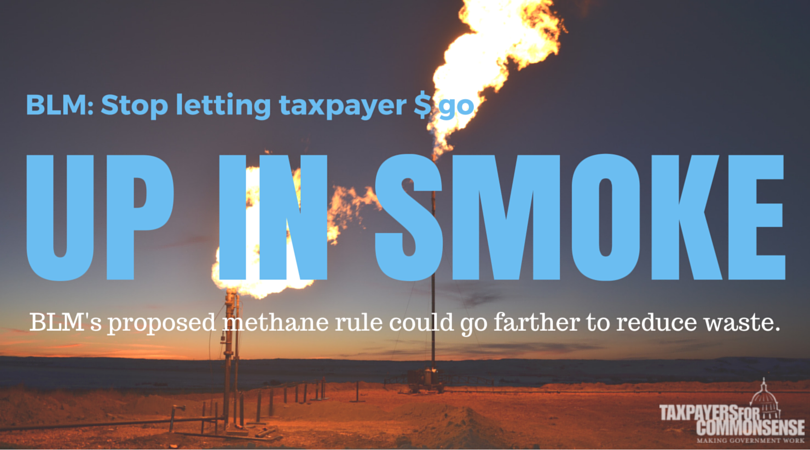
Today is the deadline for comments to the Bureau of Land Management (“BLM”) on its proposed rule dealing with the loss of natural gas from oil and gas drilling on federal lands. TCS weighed in, focusing as you might expect on how the new rules affect taxpayers. The country owns this gas after all, and taxpayers should be compensated for letting companies extract and sell it.
First, a little background: between 2009 and 2014 oil and gas companies wasted enough natural gas from onshore federal and Indian leases to power the state of Illinois for a year. Because the rules for wasting gas are so vague and out-of-date, companies did not have to pay royalties on this gas. In 2013 alone, $392 million worth of natural gas was lost.
So BLM has finally proposed updating the antiquated rules, which are more than 35 years old. We’ve known they were a problem for years. In 2010, the Government Accountability Office (GAO) found that around 40 percent of natural gas lost from onshore Federal leases could have been captured economically with the use of control technologies already available. In 2011, GAO found that, “Interior did not have reasonable assurance that it was collecting its share of revenue from oil and gas produced on federal lands.”
The BLM’s proposed changes fix many of the long-standing problems, but the new rules fall short and could be strengthened to better prevent waste and ensure taxpayers are receiving a fair return for these resources:
- The BLM is proposing to treat oil and gas wells that are connected to pipelines differently from those that are not. Huh? Namely, if an oil company burns off or flares excess natural gas from a well connected to a pipeline, that gas is subject to a royalty payment. Wells that are not connected to this so-called “gathering” infrastructure do not have to pay royalties on gas that is burned off. It’s the same waste. All gas that is systematically flared (burned) at a well should be subject to a royalty because it is taxpayers’ gas and there is technology companies could use to capture it. It shouldn’t just be burned off.
- The new rule prohibits venting or releasing gas directly into the air. This is good. It also limits the amount of gas an operator can flare. Also good. However, the limits for flaring (1,800 million cubic feet per month per well) seem arbitrary, and there is not enough explanation for why this cannot be lower. The state of Alaska for example prohibits all venting and flaring, so drilling companies in that state inject excess gas back into the well. When gas is lost instead of sold, it usually doesn’t get charged a royalty – it is just a waste of taxpayers’ resources.
- The BLM, exercising its authority to control the pace and location of development – which it should do more of – wants drilling companies to submit a plan to limit wasted gas with their application to drill. This makes a lot of sense. Unfortunately, BLM has opted not to make these plans enforceable. This makes no sense. If BLM is going to require these plans, it should enforce them. Otherwise, what’s the point? Again, less waste equals more royalties.
- Finally, BLM wants to change the rule so it follows the federal law that governs leasing of public lands for mining coal, petroleum, and natural gas. Seems like kind of a no-brainer. BLM’s current regulations for royalty rates collected from onshore oil and gas leases is set a flat rate of 12.5 percent, even though it is authorized to specify a higher royalty rate. BLM’s failure to raise onshore royalty rates since the 1970s represents a significant loss to taxpayers. Fair return to taxpayers is a competitive rate of return—a royalty rate that is consistent with those charged on state and private lands, which are generally higher than 12.5 percent. BLM should increase the royalty rate to 18.75 percent for onshore oil and gas production, a rate consistent with federal offshore oil and gas production and the prevailing state and private royalty rates.
Overall, we are encouraged by BLM’s proposed rule, even though we think it can go further. Revenues from the collection of royalties represent one of the largest non-tax income sources for the federal government, so we shouldn’t let it go up in smoke.










